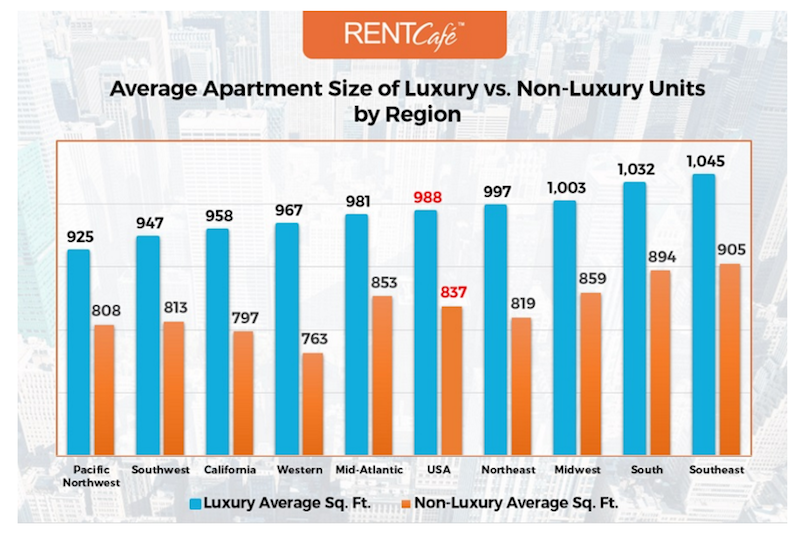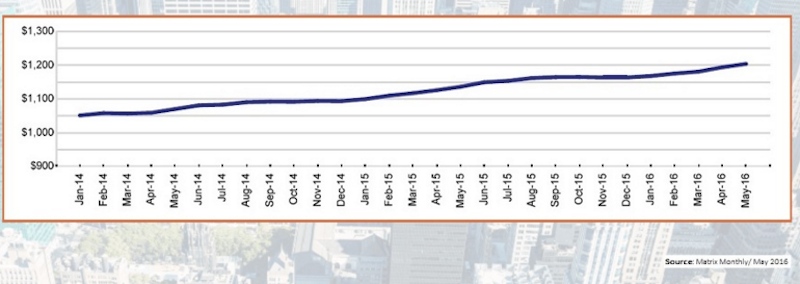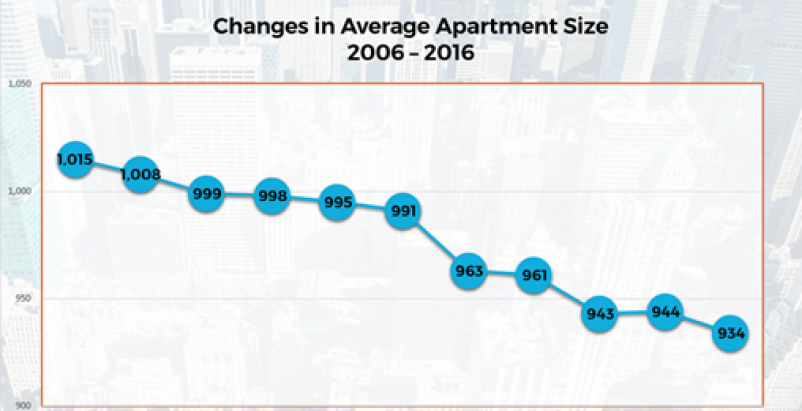The average new apartment in the U.S. is about 8% smaller than the average was a decade ago. And that shrinkage wasn’t confined to urban markets, either.
Those are two of the main findings in a recent survey of the apartment market, conducted by RENTCafé, a nationwide apartment search website, using data provided by Yardi Matrix, a sister company that researches and reports on multifamily properties of 50 units or more across 121 markets in the U.S.
That research shows the size of new apartments averaging 934 sf, versus 1,015 sf in 2006. New studio apartments took the steepest decline, to an average 504 sf this year from 614 sf a decade ago, representing a nearly 18% difference. New two-bedroom apartments, on the other hand, at 1,126 sf, are actually 1% larger than the average for that apartment type in 2006.
RENTCafé estimates that the average apartment size in the U.S., regardless of when it was built, is 889 sf. There are three regions of the country that exceed the average—the Southeast (974 sf), South (937), and Mid-Atlantic (891).

The southern regions of the U.S. still give renters the most for their buck, in terms of average apartment size. Image: RENTCafe
The largest gap between luxury and non-luxury apartment sizes is in the western states, 967 sf vs. 763 sf. Conversely, the gap between luxury and non-luxury apartments in the Southeast is relatively narrow: 1,045 sf vs. 905 sf.
Atlanta leads all cities with the largest average apartments, followed by Plano, Texas; Jersey City, N.J.; Henderson, Nev.; and Chesapeake, Va. Arizona has three of the five cities—Tucson, Glendale, Mesa—with the smallest average apartment sizes. (El Paso, Texas, and Buffalo, N.Y., fill out that ranking).
By far, Atlanta leads all cities with the largest average two-bedroom apartments, at 1,125 sf; Jersey City is its closest rival in that category, at 1,097 sf.
Interestingly, neither New York, San Francisco, nor Boston—three cities where the micro apartment crae hit first—ranks among the top 20 cities for smallest apartment size. (In fact, Boston is No. 10 in among the cities with the largest average apartments.)
“But that doesn’t erase the fact that Manhattan remains the nation’s tightest market, with average rents reaching a whopping $4,043 per month, more than three times the national average,” Yardi Matrix data show.
RENTCafé’s survey breaks down 95 metros and their average apartment sizes by studio, one-bedroom, and two-bedroom. In Los Angeles, the country’s largest city, a studio apartment averages 524 sf, a one-bedroom 729 sf, and a two-bedroom 1,043 sf. Reno, Nev., has the smaller average studios (352 sf), Stockton, Calif., the smaller average one-bedroom (632 sf), and Buffalo the smallest average two-bedroom (843 sf).

Despite the shrinkage in apartments, rents aren't retreating. Image: RENTCafe
The survey cautions, however, that while apartments are shrinking, their rents may not be. “Apartment rents are breaking record after record,” with the national monthly rent hitting an average of $1,204 in May, the report states. In San Francisco, “you’ll still be paying $2,500 for a 500-sf studio.”
There is increasing demand for high-density housing with mixed-use components, which are being directed specifically at Millennials and downsizing Baby Boomers.
Another thing that hasn’t changed: Renters desire apartment buildings with lots of amenities. RENT Café points to Eastown, the largest apartment community delivered to L.A.’s rental market last year. Located in Hollywood, the community includes a pool and spa with lounges, a fireplace and patio area, a gym and fitness center, and electric vehicle charging stations. Rents start at $1,925 for a 571-sf apartment.
 The average size of a new apartment in the U.S. has been on a steady decline for the past 10 years, according to a new survey that tracks apartment sizes in most major metros across the country. Image, which shows average square footage by year: RENTCafe
The average size of a new apartment in the U.S. has been on a steady decline for the past 10 years, according to a new survey that tracks apartment sizes in most major metros across the country. Image, which shows average square footage by year: RENTCafe
Related Stories
Adaptive Reuse | Jul 27, 2023
Number of U.S. adaptive reuse projects jumps to 122,000 from 77,000
The number of adaptive reuse projects in the pipeline grew to a record 122,000 in 2023 from 77,000 registered last year, according to RentCafe’s annual Adaptive Reuse Report. Of the 122,000 apartments currently undergoing conversion, 45,000 are the result of office repurposing, representing 37% of the total, followed by hotels (23% of future projects).
Multifamily Housing | Jul 25, 2023
San Francisco seeks proposals for adaptive reuse of underutilized downtown office buildings
The City of San Francisco released a Request For Interest to identify office building conversions that city officials could help expedite with zoning changes, regulatory measures, and financial incentives.
Sponsored | Multifamily Housing | Jul 20, 2023
Fire-Rated Systems in Light-Frame Wood Construction
Find guidance on designing and building some of the most cost-effective, code-compliant fire-rated construction systems.
Multifamily Housing | Jul 13, 2023
Walkable neighborhoods encourage stronger sense of community
Adults who live in walkable neighborhoods are more likely to interact with their neighbors and have a stronger sense of community than people who live in car-dependent communities, according to a report by the Herbert Wertheim School of Public Health and Human Longevity Science at University of California San Diego.
Affordable Housing | Jul 12, 2023
Navigating homelessness with modular building solutions
San Francisco-based architect Chuck Bloszies, FAIA, SE, LEED AP, discusses his firm's designs for Navigation Centers, temporary housing for the homeless in northern California.
Sponsored | Fire and Life Safety | Jul 12, 2023
Fire safety considerations for cantilevered buildings [AIA course]
Bold cantilevered designs are prevalent today, as developers and architects strive to maximize space, views, and natural light in buildings. Cantilevered structures, however, present a host of challenges for building teams, according to José R. Rivera, PE, Associate Principal and Director of Plumbing and Fire Protection with Lilker.
Mass Timber | Jul 11, 2023
5 solutions to acoustic issues in mass timber buildings
For all its advantages, mass timber also has a less-heralded quality: its acoustic challenges. Exposed wood ceilings and floors have led to issues with excessive noise. Mass timber experts offer practical solutions to the top five acoustic issues in mass timber buildings.
Multifamily Housing | Jul 11, 2023
Converting downtown office into multifamily residential: Let’s stop and think about this
Is the office-to-residential conversion really what’s best for our downtowns from a cultural, urban, economic perspective? Or is this silver bullet really a poison pill?
Adaptive Reuse | Jul 10, 2023
California updates building code for adaptive reuse of office, retail structures for housing
The California Building Standards Commission recently voted to make it easier to convert commercial properties to residential use. The commission adopted provisions of the International Existing Building Code (IEBC) that allow developers more flexibility for adaptive reuse of retail and office structures.

















